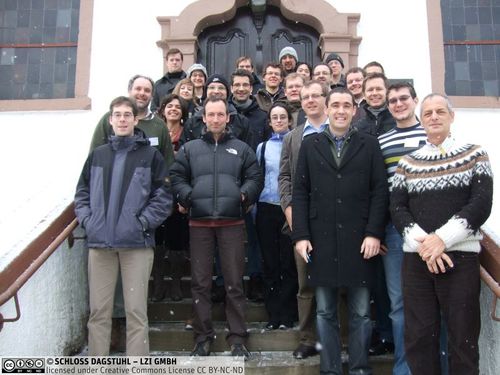Dagstuhl Seminar 10011
Pervasive Public Displays
( Jan 03 – Jan 08, 2010 )
Permalink
Organizers
- Nigel Davies (Lancaster University, GB)
- Antonio Krüger (DFKI - Saarbrücken, DE)
- Marc Langheinrich (University of Lugano, CH)
- Albrecht Schmidt (Universität Stuttgart, DE)
- Martin Strohbach (NEC Laboratories Europe - Heidelberg, DE)
Contact
This Dagstuhl seminar has focused on bringing together researchers from a diverse set of fields of Computer Science to discuss the next generation of pervasive public display environments. The state-of-the-art in software control of display environments is best represented by commercial products that enable advance scheduling of content on a network of displays. Essentially such systems offer a traditional broadcast model based on linear playout of content and offer no support for user recognition or interaction with displays. Other display environments, e.g., in offices or conference centres, might simply run single, isolated applications, such as video conferencing or video players. In addition, current systems typically function as small isolated networks consisting of a limited number of displays under a single management domain (e.g. in a single shopping centre). In this respect, a parallel can be drawn with the state of computing prior to the invention of the Internet - machines were networked together in small clusters to facilitate resource sharing, control and communication but there were no mechanisms for interconnecting these networks.
The focus of the seminar was on future systems designed to be fundamentally different different public, semi-public, and private spaces. Specifically, instead of displays showing linear presentations that have been created and scheduled in advance it is possible to imagine that future displays will be highly interactive and show information personalised to viewers and their context. Such personalization could be achieved by, for example, detecting the proximity of individuals to the display through detection of the presence of a personnel device such as a mobile phone with Bluetooth enabled. Secondly, it is envisaged that these advanced display systems will transition from small, isolated islands to a single global network of interactive displays and associated sensors. Such a platform would enable the removal of the traditional static, tight coupling between display owners and content producers and create a new dynamic system in which display ownership and content production are decoupled. This would, in turn, create the potential for new business models to emerge within the context of a new global communications medium.
The seminar has considered key areas related to next generation display networks including:
- Protocols and Services to Support Next Generation Display Networks
- User Interaction with pervasive displays
- Tensions between privacy and personalisation
- Business and legislative requirements for pervasive display networks
This Dagstuhl seminar presented an unique and exciting opportunity to bring together representatives from these fields with the explicit aim of advancing the state of the art in public display systems. The main goal was to help kickstart international collaborative research and deployments and to begin to define the shape of future display networks. There will be plenty of opportunities for participants to present and discuss their own work as well as participating in discussions. We hope that the seminar has the potential to be noted as the birth-place of new ideas in an area with enormous potential impact in academia, industry and everyday life.
- Florian Alt (Universität Duisburg-Essen, DE) [dblp]
- Keith Cheverst (Lancaster University, GB) [dblp]
- Chi Tai Dang (Universität Augsburg, DE)
- Nigel Davies (Lancaster University, GB) [dblp]
- Alexander De Luca (LMU München, DE) [dblp]
- Tanja Döring (Universität Bremen, DE)
- Tobias Hesselmann (OFFIS - Oldenburg, DE)
- Christian Kray (University of Newcastle, GB)
- Antonio Krüger (DFKI - Saarbrücken, DE) [dblp]
- Tsvi Kuflik (Haifa University, IL) [dblp]
- Marc Langheinrich (University of Lugano, CH) [dblp]
- Nemanja Memarovic (University of Lugano, CH)
- Jörg Müller (Universität Münster, DE) [dblp]
- Helder Pinto (Ubisign - Braga, PT)
- Michael Rohs (LMU München, DE) [dblp]
- Enrico Rukzio (Universität Duisburg-Essen, DE) [dblp]
- Sarah Rutlidge (Lancaster University, GB)
- Albrecht Schmidt (Universität Stuttgart, DE) [dblp]
- Lübomira Spassova (DFKI - Saarbrücken, DE)
- Frank Steinicke (Universität Würzburg, DE) [dblp]
- Martin Strohbach (NEC Laboratories Europe - Heidelberg, DE) [dblp]
- Axel Sylvester (Universität Hamburg, DE)
- Lucia Terrenghi (Vodafone R&D - München, DE) [dblp]
- Massimo Zancanaro (Bruno Kessler Foundation - Trento, IT)
Classification
- Ubiquitous Computing
- HCI
- Mobile Computing
Keywords
- Public Displays
- Ubiquitous Computing


